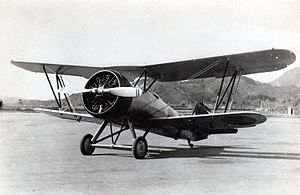avia.wikisort.org - Aeroplane
The Nakajima A4N was a carrier-based fighter used by the Imperial Japanese Navy, and the last biplane designed by Nakajima. The first prototype was completed in 1934, but due to engine trouble the aircraft did not see service until 1936. Given the Nakajima internal designation Nakajima YM, the Japanese Navy designation was Navy Type 95 Carrier Fighter. A total of 221 were built.[1]
| A4N | |
|---|---|
 | |
| Role | Fighter aircraft |
| National origin | Japan |
| Manufacturer | Nakajima Aircraft Company |
| First flight | Autumn 1934 |
| Introduction | January 1936 |
| Primary user | Imperial Japanese Navy Air Service |
| Produced | 1935-1940 |
| Number built | 221 |
| Developed from | Nakajima A2N |
Specifications (A4N1)
Data from Japanese Aircraft, 1910–1941[1]
General characteristics
- Crew: 1
- Length: 6.64 m (21 ft 9 in)
- Wingspan: 10 m (32 ft 10 in)
- Height: 3.07 m (10 ft 1 in)
- Wing area: 22.89 m2 (246.4 sq ft)
- Empty weight: 1,276 kg (2,813 lb)
- Gross weight: 1,760 kg (3,880 lb)
- Powerplant: 1 × Nakajima Hikari 1 9-cylinder air-cooled radial piston engine, 500 kW (670 hp) to 544 kW (730 hp)
- Propellers: 2-bladed Hamilton Standard fixed-pitch metal propeller
Performance
- Maximum speed: 352 km/h (219 mph, 190 kn) at 3,200 m (10,499 ft)
- Cruise speed: 233 km/h (145 mph, 126 kn)
- Range: 846 km (526 mi, 457 nmi)
- Service ceiling: 7,740 m (25,390 ft)
- Time to altitude: 3,000 m (9,843 ft) in 3 minutes 30 seconds
- Wing loading: 76.9 kg/m2 (15.8 lb/sq ft)
- Power/mass: 0.2884 kW/kg (0.1754 hp/lb)
Armament
- Guns: 2× fixed, forward-firing 7.7 mm machine guns
- Bombs: 2× 30 kg or 2× 60 kg bombs
See also
Related development
Related lists
- List of aircraft of Japan during World War II
- List of military aircraft of Japan
References
Wikimedia Commons has media related to Nakajima A4N.
Notes
- Mikesh & Abe 1990, pp. 232–233
Bibliography
- Mikesh, Robert C.; Abe, Shorzoe (1990). Japanese Aircraft, 1910-1941. London: Putnam Aeronautical Books. ISBN 0-85177-840-2.
- Passingham, Malcolm (November 1995). "Les premiers chasseurs embarqués Nakajima (3e partie): Le A4N1 Type 95" [The First Nakajima Carrier Fighters, Part 3: The A4N1 Type 95]. Avions: Toute l'aéronautique et son histoire (in French) (33): 7–13. ISSN 1243-8650.
На других языках
- [en] Nakajima A4N
[fr] Nakajima A4N
Le Nakajima A4N était un avion de chasse embarqué utilisé par la Marine impériale japonaise. Il fut également le dernier biplan produit par Nakajima. Le premier prototype a effectué son premier vol en automne 1934, mais à la suite de problèmes de motorisation, il a fallu attendre l'automne 1936 pour le voir entrer en service. La marine japonaise le désigna Type 95, et en tout 221 appareils furent produits de 1936 à 1940. Ces avions furent principalement utilisés durant la guerre sino-japonaise (1937-1945).[it] Nakajima A4N
Il Nakajima A4N (九五式艦上戦闘機 Nakajima kyūgoshikikanjōsentōki?), indicato anche come Caccia Imbarcato della Marina Tipo 95 (?) in base alle convenzioni allora vigenti, fu un aereo da caccia imbarcato monomotore biplano sviluppato dall'azienda aeronautica giapponese Nakajima Hikōki KK nei primi anni trenta.[ru] Nakajima A4N
Nakajima A4N (яп. 九五式艦上戦闘機), палубный истребитель флота, Тип 95) — японский палубный истребитель-биплан времён японо-китайской войны. Разрабатывался компанией «Накадзима» как дальнейший этап развития Nakajima A2N. Последний японский палубный истребитель-биплан.Текст в блоке "Читать" взят с сайта "Википедия" и доступен по лицензии Creative Commons Attribution-ShareAlike; в отдельных случаях могут действовать дополнительные условия.
Другой контент может иметь иную лицензию. Перед использованием материалов сайта WikiSort.org внимательно изучите правила лицензирования конкретных элементов наполнения сайта.
Другой контент может иметь иную лицензию. Перед использованием материалов сайта WikiSort.org внимательно изучите правила лицензирования конкретных элементов наполнения сайта.
2019-2025
WikiSort.org - проект по пересортировке и дополнению контента Википедии
WikiSort.org - проект по пересортировке и дополнению контента Википедии